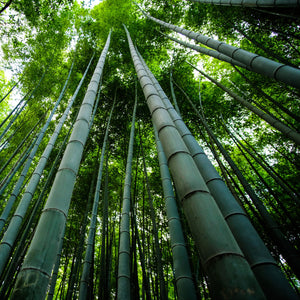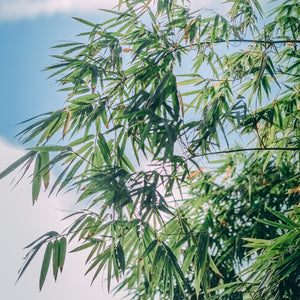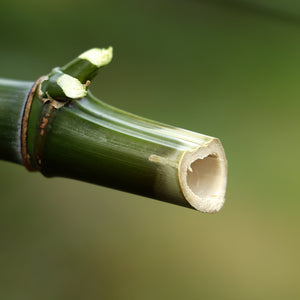
Facts about bamboo
Bamboo has become known in just a few years as the super eco-friendly choice when buying clothes, flooring or household items. But what exactly is bamboo?
Bamboo is a collective term for woody grasses (Bambusoideae) from subtropical and tropical regions and thus technically grasses. It includes 1,575 species, divided into 111 genera. It was the German botanist, Charles Kunth, who first published his taxonomic findings in 1815.
Bamboo is the largest and only grass species that can diversify into forests. Although bamboo is a grass, many species resemble trees, but with some significant differences.
A tree grows both in diameter and height each year, while bamboo reaches its full height in a single season, but it gradually puts out more lateral branches and twigs. In addition, bamboo has no bark, but protective leaves in its early stages of development.

IS BAMBOO JUST BAMBOO?
Bamboo consists of many different species with unique growth rates. Some grow up to 1 meter per day in optimal soil and climate conditions and can reach up to 40 meters. Others only grow a few centimeters.
Some bamboo species bloom at intervals of up to 60 years, and the flowering is often synchronized over large areas. This is hard on the animals that feed on the bamboo, as the plants wither completely after flowering. But soon after, new shoots grow, and the cycle continues.

Bamboo is an extremely resilient plant
If the bamboo shoots are planted on a wasteland, they may need a little pesticide to grow. But after that, no pesticides or fungicides are required, thanks to the antibacterial properties of bamboo.
Bamboo is a very resilient plant and the only one to survive the radiation from the bombing of Hiroshima. The atomic bomb destroyed all trees and plant life, except for a bamboo grove, which later grew back. Bamboo only needs small amounts of sun and water to grow, so it is a non-resource-intensive crop.

WHERE DOES BAMBOO GROW?
Bamboo grows primarily in Africa, Asia, South America, North America and Australia. In Europe, we are therefore forced to import bamboo. However, bamboo plantations have a positive effect on CO2 emissions, as bamboo absorbs four times more CO2 and produces 35% more oxygen than a similar amount of trees.
The plant tolerates extreme conditions and can in principle grow anywhere – at sea level, at over 4000 meters in the Andes or at -20 degrees in the Himalayas. However, the species in Europe grow more slowly and do not grow as tall as those in China.
The bamboo plant improves the soil and prevents erosion, as the roots remain in the soil when harvested and the plant grows back. This minimizes deforestation and makes more space for other crops, such as food.
Around 100 species are used commercially and they are not the same species that pandas eat. 20 of these species are prioritized for bamboo plantations and are grown outside the animals' natural habitats.
HOW DOES THE BAMBOO PLANT BECOME BEAUTIFUL, SOFT TEXTILES?

